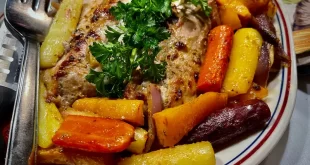Be informed and confident in the kitchen with this guide to pork safety.

Way back in the olden days (prior to May 2011), the USDA’s safe temperature guideline for pork chops was 160 degrees F°, which resulted in tough, dry shoe leather. As it turns out, pork used to carry a pathogen that caused trichinosis, a food-borne illness.
However, thanks to improved breeding practices, trichinosis from pork is no longer a health concern today. You can rest assured that if your pork chop’s temperature is 145 degrees F, you’ll have safely-cooked meat that’s moist, juicy, and just slightly pink in the center.
Whether the pork is boneless, bone-in, and regardless of the cooking method (i.e. grilling, roasting, frying, etc), the internal temperature should be the same. If you’ve been cooking your pork at a higher heat and found your meat to be dry and tough, there’s your answer.
How to Check the Temperature of Pork
The easiest way to check the internal temperature of pork is by using an instant-read meat thermometer. To do so, slide the thermometer into the middle of the thickest part of the chop. Take care to stay in the middle of the chop without breaking through to the pan, which will affect the reading.
Additionally, the thermometer should not be touching fat, bone or gristle. For the easiest reading, slowly insert the thermometer at a 45-degree angle, instead of straight down.
If you don’t have a meat thermometer, prick the pork with a fork or knife and check that the juices run clear. If they have more than a very slight hint of pink, put the pork back in to cook more. You can also press the top of the pork with tongs or your fingertip to test the texture.
If the pork feels firm but springs back to shape with clear juices, it’s done. Raw meat will feel soft and release a darker liquid. If the meat feels very firm and does not release juice, it’s most likely overcooked.
Does Pork Need to Rest After Cooking?
Yes, a thick cut of meat, like a pork chop or shoulder, should rest for 10 to 15 minutes before cutting and serving. The reason behind this is because hot meat releases more liquid when cut, thereby drying out the pork. If you rest the pork before cutting, the cooled meat will distribute the juices, which ensures a juicy and tender cut.
Thinner cuts should rest as well, but may need less time. A good rule of thumb is to let the meat rest for half of its cooking time. For example, if it took 20 minutes to cook a pork chop, the chop should rest for 10 minutes before serving.
When resting pork, leave the meat on a warm surface, such as the top of the unlit stove. Avoid tenting smaller cuts, like pork chops, with aluminum foil, as this will trap the heat and cook the meat further. The exception to this rule is with large cuts intended for shredding, such as pork shoulder; place these pieces on a cutting board and loosely tent it with foil for 15 to 20 minutes before shredding.
What Should the Temperature be For Other Cuts of Pork?
However, ground pork should always be cooked to 160° with no hint of pink. Grinding pork exposes the meat to a higher level of bacteria, so it’s essential to cook it to a higher temperature than other cuts.
If you’re cooking a very large piece of pork, such as pork shoulder or pork butt, cook the meat to between 195 and 205 degree F. The higher temperature allows the collagen in the meat to break down, ensuring a tender pulled pork.



